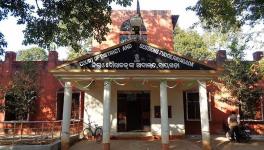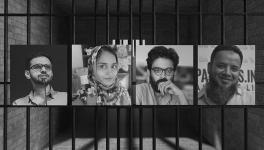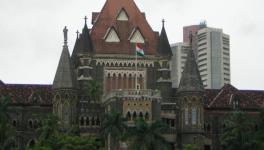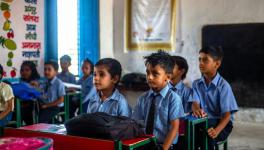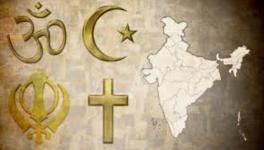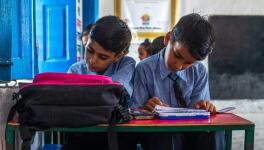CAA-NRC: Protesters Fight for Nation While Delhi Elections Loom
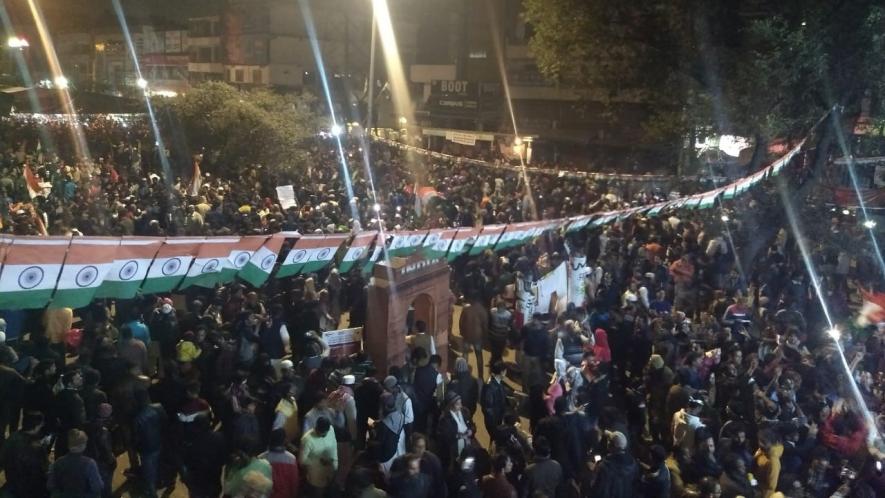
The sit-in at Shaheen Bagh began on the night of 14 December, right after the students of Jamia Millia Islamia were brutally attacked by Delhi Police. It is because of the protester’s immense faith in the Indian Constitution that their movement has only strengthened, never weakened, since that day. Shaheen Bagh has become the model for open-air anti-CAA-NRC-NPR protests that have spread across the country. At least fifty sites—around a dozen of them in Delhi—have modelled themselves on it.
On Sunday, when India marked the completion of 70 years as a republic, a tremendous gathering at Shaheen Bagh reflected on the Constitution that gave all Indian citizens equal rights to participate in national processes. This gathering, mostly spearheaded by Muslim women, should be seen against the backdrop of the last seven decades. If, in all these years, there was one consistent complaint raised by citizens, it was that minorities and women were aloof, or sidelined, from the advancement of the nation.
The irony of this moment is that women—mostly Muslim women—have taken the lead in organising anti-CAA demonstrations, but they are being branded as unacceptable and anti-national for doing so. The scores of Shaheen Baghs across the country have turned India into a site of the biggest ever sit-ins organised by women, who are mostly Muslim, though by no means is this an exclusively Muslim project. Yet, those who once complained bitterly that Muslims are not ‘mainstream’ enough, are now saying that women of the community ought not to have stepped out to demand their rights.
The mainstream media is doing its best to cast every single Shaheen Bagh as a “conspiracy” hatched by shadowy figures from the Muslim community. It is playing up their fractures, divisions—and flaws—which should only be expected to occur in a movement that has no defined leadership.
A few months ago, the media’s refrain was that the Muslims are backward, inward-looking, isolated, and that Muslim women in particular are being prevented by Muslim men from participating in national developments. Now these very voices are saying that Muslim women are being ‘used’ for nefarious designs against the country. The protesters are being named dangerous, anti-national, ‘tukdey-tukdey’ gang members, and whatnot. This narrative refuses to acknowledge the alternative possibility: that Muslim women understand—like any ordinary women—their responsibility towards the country and its secular ideal.
Despite these obvious ironies, the courts did not come to the rescue of the hundreds who were thrashed at Jamia for opposing the Citizenship Amendment Act. The apex court also refused to stay the CAA—the same court which has delayed fulfilling many other requests of the weaker sections. But despite such paradoxes, the spirit of the protesters at Shaheen Bagh, Jamia Millia Islamia, Khureji Khas, Jaffrabad and other protest sites remains high.
We do not know what the future holds. Elections to Delhi’s Assembly are around the corner. The Delhi Police is controlled by the central government. How this tightly-contested political battle will impact these well-attended round-the-clock vigils to save the Constitution and secularism is impossible to predict. However, if the matter was only up to the women oiling the wheels of these sit-ins, they are here for the long haul.
The demand raised by the women (and men) is simple—they want to ensure that the Constitution’s supremacy is upheld. Therefore, they are rejecting the CAA’s deliberate infusion of religion into the idea of Indian citizenship. Even more, they are refusing to accept the proposal for an all-India NRC.
Due to these demands there is a feeling that trouble of some kind will be wrought on these protests, but we still do not know how things will unfold. Whatever happens, and as much as right-wing elements would like to project these protests as Muslim-centric, the walls of suspicion crumble once you are actually in Shaheen Bagh.
Muslims—and they may be completely oblivious to this fact—are keeping the mantle of nationalism intact at Shaheen Bagh. At every single protest site, they are bringing back the patriotism of India’s freedom movement. They have made repeated calls for all social groups and classes to participate in these protests. And there is participation from non-Muslims. Together, all the protesters are reviving the symbols attached to India’s freedom struggle and republicanism. These symbols have been injected afresh into the national discourse. In these two ways, Shaheen Bagh is already a success.
Many want us to believe that Shaheen Bagh is a fight only for the survival of Muslims, but even this is untrue. Theirs is a fight to keep Indian nationhood intact. You would ask, how do I know this? I know because the protesting women have been saying so repeatedly, and there is no reason not to believe them. They have been pointing out that the discriminatory law that the CAA is should be revoked. And they have been saying that the planned roll-out of NRC across the nation and the National Population Register will change the dynamic of India’s democracy for the worse. This is a view that all but the most ardent ideologues of the ruling dispensation subscribe to. It is a view that the international community has taken, too.
The protesters do not deny that the Muslims will suffer, and suffer badly, through these two interventions of the central government. Yet, the women of Shaheen Bagh, and the speakers and protesters there, have also been pointing out that the Muslims will not be the only ones to go through the ordeal of proving their citizenship for the NRC. Dalits, tribals and the poor from every segment of the population will suffer, some as badly as the Muslims, some even worse. That is why they want the proposed all-India NRC thwarted.
These protests are rebuilding the communal fabric that had weakened over the last several decades, in the absence of concrete efforts to build bridges between social groups. Their only claim is that the freedom struggle led by Mahatma Gandhi was for a secular and inclusive India and not a country where people could be discriminated against on religious grounds. To recreate the same passion triggered by these ideas in the forties and fifties, to ensure all unite to reclaim the lost space, the protesters are deploying the same slogans and patriotic practices that had melded communities during the freedom movement.
But to comprehend their nationalist fervour, you have to go to Shaheen Bagh—not watch the communal propaganda floating as news on television screens. These protesters are lifting the heavy dust that the Partition had thrown over the memories of the joint freedom movement. Much has happened in independent India that makes it difficult to espouse and live by Sarvadharma Samabhava, for which Mahatma Gandhi lived and died.
However things turn out at the Shaheen Baghs across the country, the protesters have made their presence felt. Many of them have stepped out on the roads to support a cause for the very first time. Gandhi had espoused integrating religious values without trying to efface religious identities. The protesters, unselfconsciously, are a living example of this powerful statement. This is a signal hard to ignore.
The longer this impasse over the CAA and NRC persists, the more are the chances that the movement will get bigger, and its impact more profound. Many, unable to appreciate the reason for the protests, will be convinced over coming weeks and months to come around to their viewpoint. The rumours will have you believe that these protesters are chanting religious slogans that are exclusively to Islamic. I have visited numerous protests and if I have heard Quranic verses, so have I heard shlokas from Hindu religious texts from the same podiums. This serves to demolish any religion or culture-based divide.
The most common slogan is revolutionary poet and icon Hasrat Mohani’s ‘Inquilab Zindabad’, which was used most often by Bhagat Singh, who laid down his life for the nation. Mohani, who also wrote ‘chupkey-chupkey, raat-din’, immortalised by Ghulam Ali, had been quite forgotten until the ongoing anti-CAA protests gave him another lease of life. Mohani was a member of the Constituent Assembly of India which drafted the Constitution and one of the founders of the Communist Party of India.
He is also remembered for his exceptional love of [the Hindu god] Krishna. There are numerous poems praising Krishna in his collection, Kulliyat-e-Hali. While many of these poems are in standard Urdu, or Urdu-e-Mualla, the rest are in Bhasha, written in Urdu script in his collection. This was the language most understood throughout the northern plains in his time. The bespectacled and bearded Hasrat Mohani took sabbaticals to Mathura, Krishna’s mythological birthplace, to meditate in seclusion...
This is the India that the protesters are reviving.
They are also chanting and singing ‘Sarfaroshi Ki Tamanna’, a slogan coined by Bismil Azimabadi, a revolutionary poet from Patna who came to be known as Ramprasad Bismil. This chilly January evenings in Delhi and elsewhere are enlivened by these verses. But to the protesters, these slogans serve as a constant reminder that this is what had kept Bismil and Ashfaqullah going despite the exceptional repression they faced.
To witness this reality, you will have to visit Shaheen Bagh, or any other protest site. You will be surprised to see them plastered with posters of national icons. The national anthem is sung throughout the day, and everybody stands in respect when it is. Sarey Jahan se Achcha keeps the mood upbeat.
Huge portraits of Mahatma Gandhi and Babasaheb Bhimrao Ambedkar eclipse all other freedom fighters on the stages. They are also the most mentioned figures in speeches and slogans. Maulana Abul Kalam Azad, the Ali brothers and Nehru are remembered too, but the Constitution or Samwidhan, is the most-heard word among the protesters. The attendees take pledges to uphold its supremacy. There is nothing but nationalist fervour visible in the multitudes of Shaheen Bagh that have cropped up in the city (and elsewhere). They are unprecedented in scale and scope; but you have to visit them to know them.
The author is a writer and columnist. The views are personal.
Get the latest reports & analysis with people's perspective on Protests, movements & deep analytical videos, discussions of the current affairs in your Telegram app. Subscribe to NewsClick's Telegram channel & get Real-Time updates on stories, as they get published on our website.












